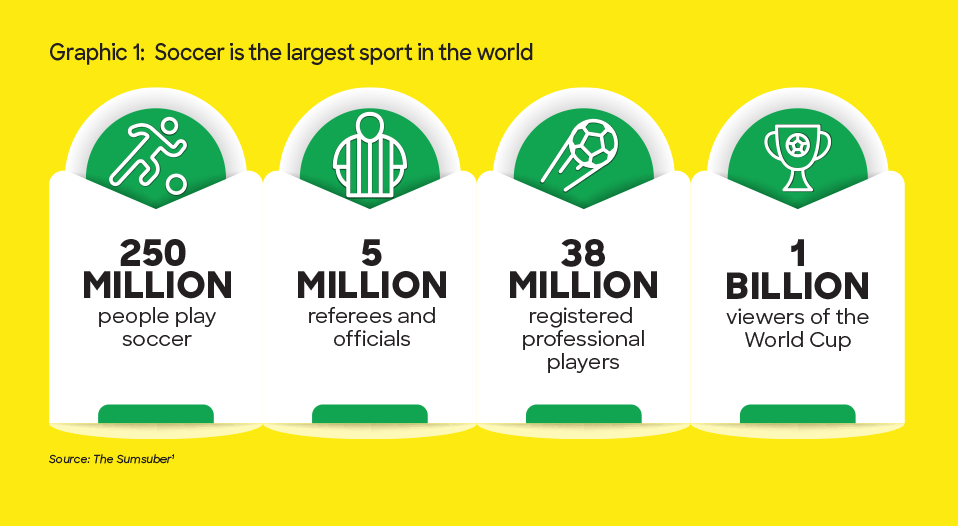
The sports world is highly dynamic, generating a vast amount of economic activity, both legal and illegal. In sports, the higher the profits, the higher the risk of money laundering. As shown in Graphic 1, soccer is the biggest sport around the world, especially in terms of business profits. This article addresses illegal activity in the world of sports―and soccer in particular.
The following are some of the different ways that money can be laundered through the sport of soccer.
- Inflated agent fees: This is when agents overcharge their fees when representing players.
- External activities: Activities such as charity games―where a nongovernmental organization (NGO) receives funds that are meant to be distributed to organizations selected by a player―can be prone to money laundering when the funds are distributed, or not, to the respective NGOs.
- Player image rights: Image rights are another technique that can be used to launder money. The clauses in Lionel Messi’s contract are one example. Through these clauses, Messi receives a percentage of the revenue from Inter Miami jersey sales as well as revenue from his games watched on Apple TV.
- Ticket sales: Tickets sold in stadiums or over the internet can also be used to launder money within the sport.
- Player transfers: Transfers between teams can also be used to mask money laundering.
- Online betting apps: Betting apps can also be a source for enabling money laundering.
The Financial Action Task Force (FATF) claims that sports like soccer, basketball, volleyball and car racing are prone to money laundering due to the large sums of money handled in cash. These sports involve player transactions, sports club structures and more.2
In the article “Is there a relationship between money laundering and sports?” the author claimed that nine executives and five businessmen were indicted on charges of bribery, fraud and money laundering in the FIFA corruption scandal that came to light in the second half of 2015. Research shows that the bribes associated with the case, which totaled $150 million, sought to influence sponsorship contracts for the FIFA-organized competitions CONCACAF and CONMEBOL that were held in the U.S. and South America.3
Cases like this are commonplace and reflect the vulnerability of the sports sector in general to money laundering. Its scope must be calculated in terms of the size and structure of the industry, whether the criminal activity is local or international and, of course, by the number of transactions that happen each day. These are all important details. Lack of ethics, the common denominator in all these situations, makes monetary inconsistencies difficult to be traced and calculated.
In recent months, the public has witnessed significant changes in soccer, such as Messi’s switch to Inter Miami. Messi’s contract, which is similar to the contract David Beckham signed in 2007, was designed in a highly peculiar fashion, giving Messi a much lower salary than the offers made by soccer teams from the Middle East.4 Beckham’s $250 million contract revolutionized Major League Soccer as it gave him rights to purchase a team within the league. Messi’s contract also gives him that option. In addition, Messi will have rights as a content creator and will receive a percentage of clothing sales and broadcast rights with Apple TV. Image rights and content creator rights are precisely those that pose a risk of money laundering in complex contracts such as these, “through sales of media rights, and merchandise, players may not declare part of the money received, the money received settles in a tax haven.”5 Although they might be highly creative ways to retain talent, these clauses represent a great risk for money laundering as they make monetary discrepancies difficult to detect.
Conclusion
Many organizations need an oversight and notification system to halt the expansion of illegal money in soccer. This is true, particularly when buying and selling sports teams, where criminals often find institutions with weak oversight that allow them to launder money and expand their money laundering networks. For soccer, FIFA and other sporting institutions must update their oversight mechanisms to reduce money laundering through their institutions as there is no significant oversight at present and this affects the sport itself as well as its image.
Carlos G. Cabrera, founder, co-chairman, CYGMA Capital LLC, carlosgcabrera@gmail.com
- Alyssa Abrams, “How Money Is Laundered Through Football,” The Sumsuber, October 28, 2022, https://sumsub.com/blog/money-laundering-football/
- “Money Laundering through the Football Sector,” Financial Action Task Force, July 2009, https://www.fatf-gafi.org/content/dam/fatf-gafi/reports/ML%20through%20the%20Football%20Sector.pdf.coredownload.pdf
- Ana Marí Perea, “¿Existe relación entre el lavado de activos y el deporte?” Tusdatos.co, https://www.tusdatos.co/blog/existe-relacion-entre-el-lavado-de-activos-y-los-deportes
- Paul Tenorio, “How Beckham’s transformative MLS contract paved the way for Messi,” The Athletic, July 10, 2023, https://theathletic.com/4674349/2023/07/10/messi-miami-beckham-money/
- Alyssa Abrams, “How Money Is Laundered Through Football,” The Sumsuber, October 28, 2022, https://sumsub.com/blog/money-laundering-football/










